Paediatric Nursing: Prioritization of Clinical Assessments and Diagnostic Data for Hyperbilirubinemia Babies
VerifiedAdded on 2023/06/18
|9
|2946
|248
AI Summary
This report discusses the prioritization of relevant clinical assessments and diagnostic data for newborn babies facing jaundice and the aetiology risk factors for critical jaundice treatment and effective support for jaundice children by nurses to their parents. It also covers the assessment and hospital management of pathologic jaundice, the role of paediatric nurses in aetiology risk factor management and treatment, and the assessment of jaundice.
Contribute Materials
Your contribution can guide someone’s learning journey. Share your
documents today.
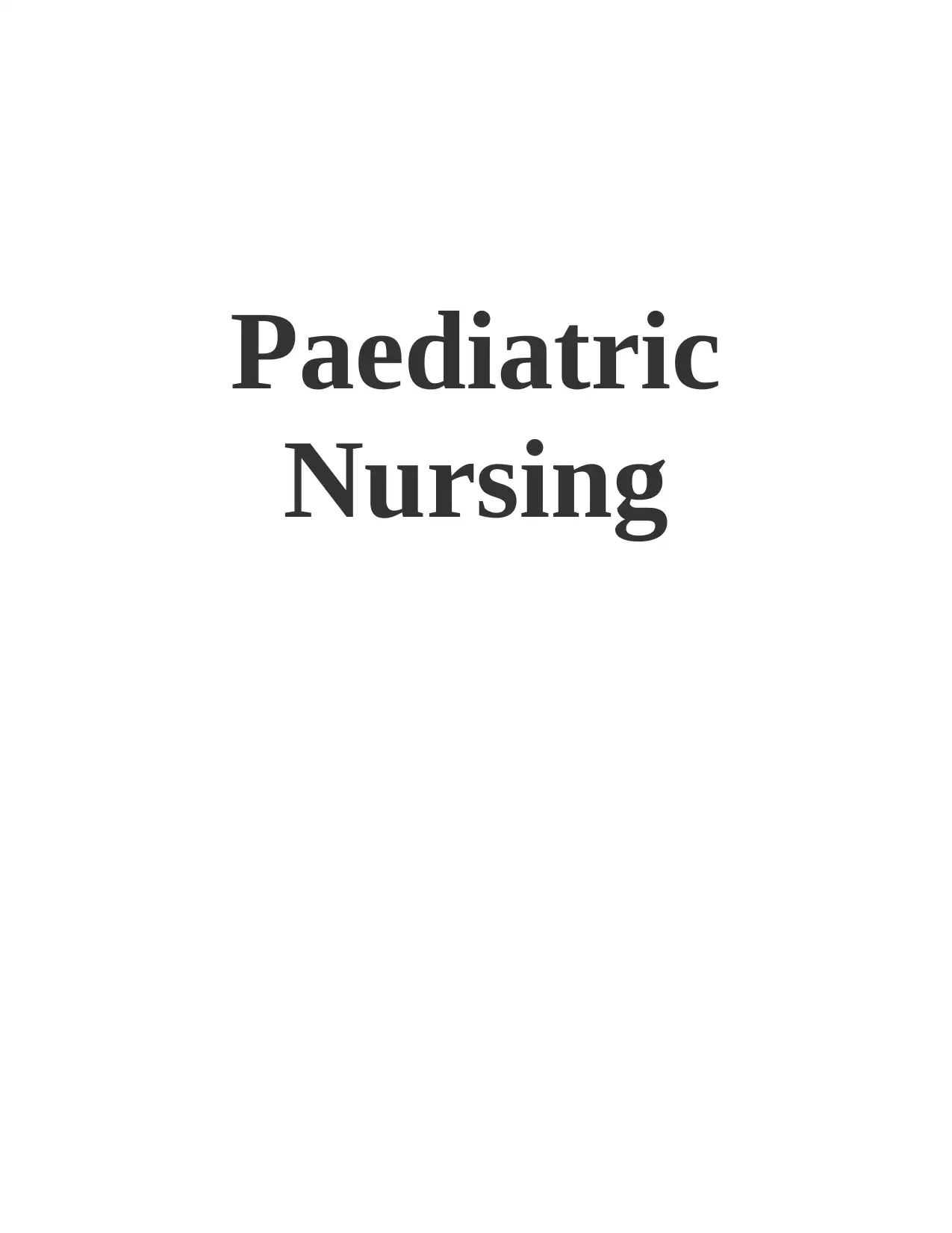
Paediatric
Nursing
Nursing
Secure Best Marks with AI Grader
Need help grading? Try our AI Grader for instant feedback on your assignments.
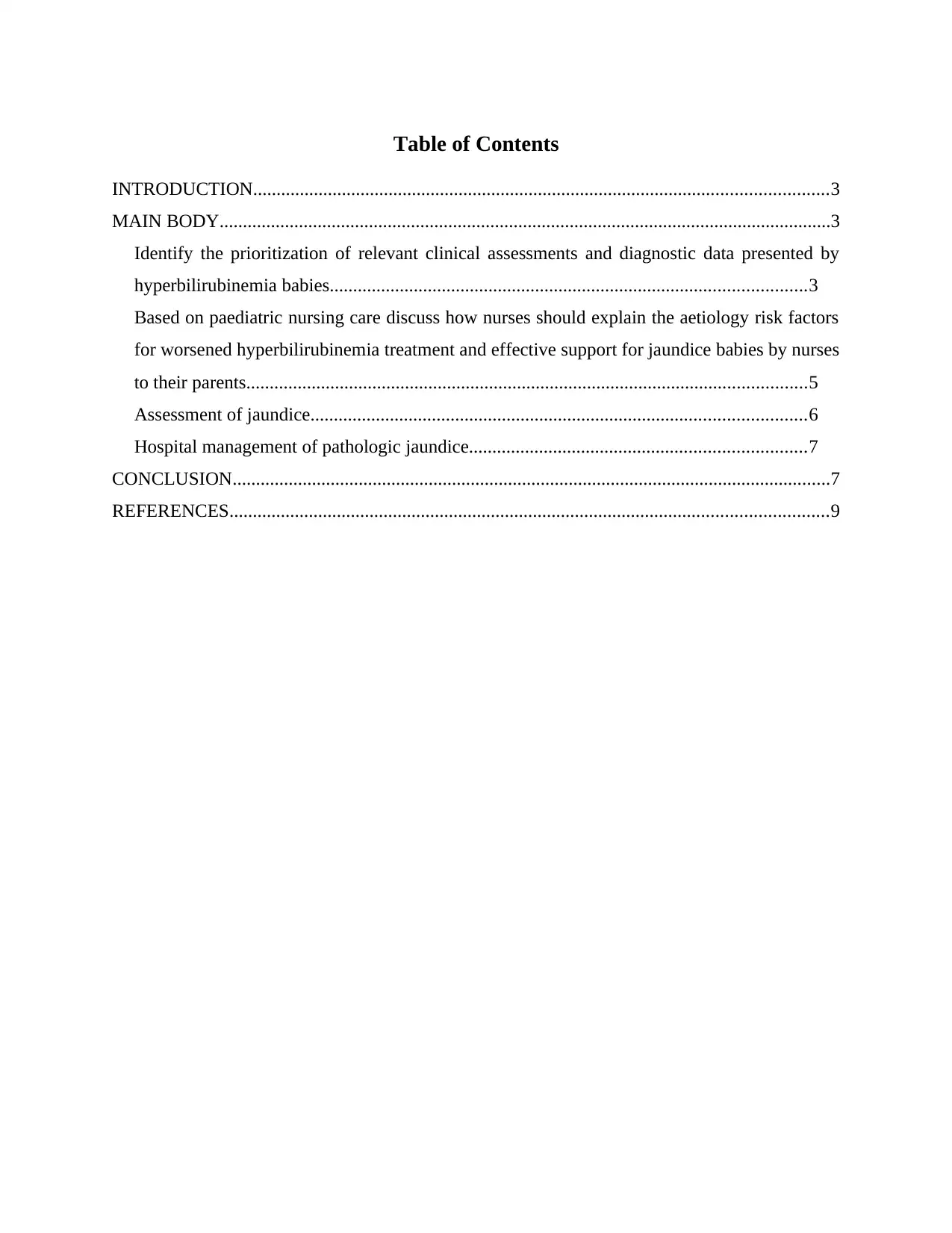
Table of Contents
INTRODUCTION...........................................................................................................................3
MAIN BODY...................................................................................................................................3
Identify the prioritization of relevant clinical assessments and diagnostic data presented by
hyperbilirubinemia babies......................................................................................................3
Based on paediatric nursing care discuss how nurses should explain the aetiology risk factors
for worsened hyperbilirubinemia treatment and effective support for jaundice babies by nurses
to their parents........................................................................................................................5
Assessment of jaundice..........................................................................................................6
Hospital management of pathologic jaundice........................................................................7
CONCLUSION................................................................................................................................7
REFERENCES................................................................................................................................9
INTRODUCTION...........................................................................................................................3
MAIN BODY...................................................................................................................................3
Identify the prioritization of relevant clinical assessments and diagnostic data presented by
hyperbilirubinemia babies......................................................................................................3
Based on paediatric nursing care discuss how nurses should explain the aetiology risk factors
for worsened hyperbilirubinemia treatment and effective support for jaundice babies by nurses
to their parents........................................................................................................................5
Assessment of jaundice..........................................................................................................6
Hospital management of pathologic jaundice........................................................................7
CONCLUSION................................................................................................................................7
REFERENCES................................................................................................................................9

INTRODUCTION
The paediatric nursing is defined as a part of nursing profession with significantly focus
around the care of children and babies which is extended to the adolescence. Moreover, they are
registered nurses who specialise in order to provide care for patient from the birth to the
adolescence in this day may have a helpful approach to develop deep knowledge of child growth
and development as diseases which is over the condition of children often present in the different
than the adults (Hopia and et. al., 2019). In this, the discussion is based on the above scenario
which indicate that the jaundice is the leading causes of death among the infants. Moreover,
hyperbilirubinemia or the jaundice is a life-threatening disorder for the new-born babies. In this,
it is also defined as a multifactorial disorder with several symptoms and signs. As per this, the
physiological jaundice is the most prevalent type of jaundice which have a different pathological
condition. In this report, it shows the prioritisation of relevant clinical assessment for the new-
born babies who is facing the condition of jaundice and diagnostic data which is play essential
role in the hyperbilirubinemia babies. The paediatric nursing is discussed with aetiology risk
factor for the critical jaundice treatment and effective support for jaundice children by the nurses
to their parents (Kim and et. al., 2018).
MAIN BODY
Priority related with clinical assessment and data related by hyperbilirubinemia new born babies
One of the most critical clinical condition in the jaundice is associated with the infants the
neonatal hyperbilirubinemia is a common clinical problem which can configure during the
neonatal period. Moreover, 8% to 11% of infants are facing the situation of jaundice. In this, the
total serum bilirubin increases above the 95% for age in the zone of high risk during the first
week of life. It is also taking as a consideration for the hyperbilirubinemia. Between 60% to 80%
of the healthy infants are expected to present with the idiopathic neonatal jaundice. Moreover,
the influence on infants is usually started with the discoloration of skin and the sclera color to
yellowish in the newborn by hyperbilirubinemia. Moreover, the incidence of neonatal
hyperbilirubinemia in-house live birth is approximate 3.3 % while the extramural admission
morbidity of the jaundice is accounted up to 22.1 %. This condition is common in 50 to 60% of
newborn babies in the first week of life (Lucio and et. al., 2019).
The paediatric nursing is defined as a part of nursing profession with significantly focus
around the care of children and babies which is extended to the adolescence. Moreover, they are
registered nurses who specialise in order to provide care for patient from the birth to the
adolescence in this day may have a helpful approach to develop deep knowledge of child growth
and development as diseases which is over the condition of children often present in the different
than the adults (Hopia and et. al., 2019). In this, the discussion is based on the above scenario
which indicate that the jaundice is the leading causes of death among the infants. Moreover,
hyperbilirubinemia or the jaundice is a life-threatening disorder for the new-born babies. In this,
it is also defined as a multifactorial disorder with several symptoms and signs. As per this, the
physiological jaundice is the most prevalent type of jaundice which have a different pathological
condition. In this report, it shows the prioritisation of relevant clinical assessment for the new-
born babies who is facing the condition of jaundice and diagnostic data which is play essential
role in the hyperbilirubinemia babies. The paediatric nursing is discussed with aetiology risk
factor for the critical jaundice treatment and effective support for jaundice children by the nurses
to their parents (Kim and et. al., 2018).
MAIN BODY
Priority related with clinical assessment and data related by hyperbilirubinemia new born babies
One of the most critical clinical condition in the jaundice is associated with the infants the
neonatal hyperbilirubinemia is a common clinical problem which can configure during the
neonatal period. Moreover, 8% to 11% of infants are facing the situation of jaundice. In this, the
total serum bilirubin increases above the 95% for age in the zone of high risk during the first
week of life. It is also taking as a consideration for the hyperbilirubinemia. Between 60% to 80%
of the healthy infants are expected to present with the idiopathic neonatal jaundice. Moreover,
the influence on infants is usually started with the discoloration of skin and the sclera color to
yellowish in the newborn by hyperbilirubinemia. Moreover, the incidence of neonatal
hyperbilirubinemia in-house live birth is approximate 3.3 % while the extramural admission
morbidity of the jaundice is accounted up to 22.1 %. This condition is common in 50 to 60% of
newborn babies in the first week of life (Lucio and et. al., 2019).
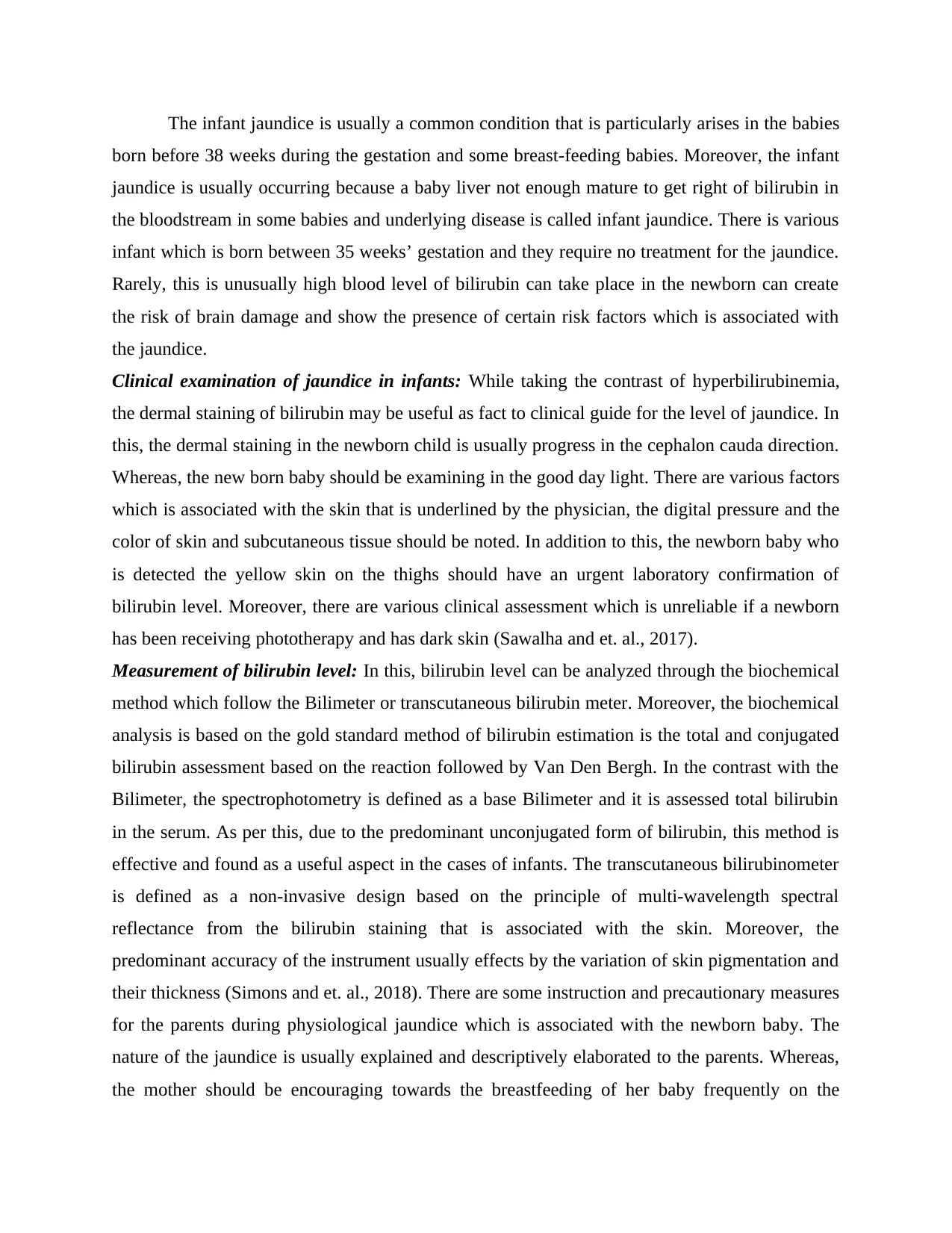
The infant jaundice is usually a common condition that is particularly arises in the babies
born before 38 weeks during the gestation and some breast-feeding babies. Moreover, the infant
jaundice is usually occurring because a baby liver not enough mature to get right of bilirubin in
the bloodstream in some babies and underlying disease is called infant jaundice. There is various
infant which is born between 35 weeks’ gestation and they require no treatment for the jaundice.
Rarely, this is unusually high blood level of bilirubin can take place in the newborn can create
the risk of brain damage and show the presence of certain risk factors which is associated with
the jaundice.
Clinical examination of jaundice in infants: While taking the contrast of hyperbilirubinemia,
the dermal staining of bilirubin may be useful as fact to clinical guide for the level of jaundice. In
this, the dermal staining in the newborn child is usually progress in the cephalon cauda direction.
Whereas, the new born baby should be examining in the good day light. There are various factors
which is associated with the skin that is underlined by the physician, the digital pressure and the
color of skin and subcutaneous tissue should be noted. In addition to this, the newborn baby who
is detected the yellow skin on the thighs should have an urgent laboratory confirmation of
bilirubin level. Moreover, there are various clinical assessment which is unreliable if a newborn
has been receiving phototherapy and has dark skin (Sawalha and et. al., 2017).
Measurement of bilirubin level: In this, bilirubin level can be analyzed through the biochemical
method which follow the Bilimeter or transcutaneous bilirubin meter. Moreover, the biochemical
analysis is based on the gold standard method of bilirubin estimation is the total and conjugated
bilirubin assessment based on the reaction followed by Van Den Bergh. In the contrast with the
Bilimeter, the spectrophotometry is defined as a base Bilimeter and it is assessed total bilirubin
in the serum. As per this, due to the predominant unconjugated form of bilirubin, this method is
effective and found as a useful aspect in the cases of infants. The transcutaneous bilirubinometer
is defined as a non-invasive design based on the principle of multi-wavelength spectral
reflectance from the bilirubin staining that is associated with the skin. Moreover, the
predominant accuracy of the instrument usually effects by the variation of skin pigmentation and
their thickness (Simons and et. al., 2018). There are some instruction and precautionary measures
for the parents during physiological jaundice which is associated with the newborn baby. The
nature of the jaundice is usually explained and descriptively elaborated to the parents. Whereas,
the mother should be encouraging towards the breastfeeding of her baby frequently on the
born before 38 weeks during the gestation and some breast-feeding babies. Moreover, the infant
jaundice is usually occurring because a baby liver not enough mature to get right of bilirubin in
the bloodstream in some babies and underlying disease is called infant jaundice. There is various
infant which is born between 35 weeks’ gestation and they require no treatment for the jaundice.
Rarely, this is unusually high blood level of bilirubin can take place in the newborn can create
the risk of brain damage and show the presence of certain risk factors which is associated with
the jaundice.
Clinical examination of jaundice in infants: While taking the contrast of hyperbilirubinemia,
the dermal staining of bilirubin may be useful as fact to clinical guide for the level of jaundice. In
this, the dermal staining in the newborn child is usually progress in the cephalon cauda direction.
Whereas, the new born baby should be examining in the good day light. There are various factors
which is associated with the skin that is underlined by the physician, the digital pressure and the
color of skin and subcutaneous tissue should be noted. In addition to this, the newborn baby who
is detected the yellow skin on the thighs should have an urgent laboratory confirmation of
bilirubin level. Moreover, there are various clinical assessment which is unreliable if a newborn
has been receiving phototherapy and has dark skin (Sawalha and et. al., 2017).
Measurement of bilirubin level: In this, bilirubin level can be analyzed through the biochemical
method which follow the Bilimeter or transcutaneous bilirubin meter. Moreover, the biochemical
analysis is based on the gold standard method of bilirubin estimation is the total and conjugated
bilirubin assessment based on the reaction followed by Van Den Bergh. In the contrast with the
Bilimeter, the spectrophotometry is defined as a base Bilimeter and it is assessed total bilirubin
in the serum. As per this, due to the predominant unconjugated form of bilirubin, this method is
effective and found as a useful aspect in the cases of infants. The transcutaneous bilirubinometer
is defined as a non-invasive design based on the principle of multi-wavelength spectral
reflectance from the bilirubin staining that is associated with the skin. Moreover, the
predominant accuracy of the instrument usually effects by the variation of skin pigmentation and
their thickness (Simons and et. al., 2018). There are some instruction and precautionary measures
for the parents during physiological jaundice which is associated with the newborn baby. The
nature of the jaundice is usually explained and descriptively elaborated to the parents. Whereas,
the mother should be encouraging towards the breastfeeding of her baby frequently on the
Secure Best Marks with AI Grader
Need help grading? Try our AI Grader for instant feedback on your assignments.

regular basis at least 8 to 12 times per day, with a note of feed or glucose water. Mother also
focuses on bringing the baby to the hospital if the color on the legs looks yellow as the face.
Moreover, any newborn discharge before 48 hours of life should be evaluated again in the 48
hours of breastfeeding efficiently for the regulation and development of jaundice. In this, the
proper management is being taken in the hospital for the mother and the baby both (Wegner and
et. al., 2017).
While taking the contrast of management of pathological jaundice, there is a confirmatory
serum bilirubin level assessment which is recommended for the baby when they are noted to
have yellowish skin color outside their thighs. Moreover, the American academy of pediatrics
has laid down various protocols and criteria in order to manage the infants with bilirubin and the
pathological ranges. The jaundice usually appears within 24 hours and they are managed as
hemolytic jaundice (Newman and et. al., 2018). There is various investigation which is taken for
the baby with bilirubin level in the underline of phototherapy includes baby blood group, RH
typing, and DCT. Whereas, it is also analyzed that the Rh factor is usually absent in the mother
or mother which contain the O blood group. In this, the packed cell volume, peripheral blood
smear, analyze for checking hemolysis and morphology of the red blood cells. As per this, the
inability is usually analyzed which shows that the factor of bilirubin is decrease up to the level of
1-2 mg per DL after 6 hours. In this, the exchange transfusion level has been defined as the
failure of phototherapy. In addition to this, irrespective of the level which is associated with the
bilirubin shows the exchange transfusion which can be performed at the smallest doubt about
encephalopathy related with the bilirubin (Essa and et. al., 2021).
Paediatric nursing role in aetiology risk factor for hyperbilirubinemia management and treatment
and analyse support and care
The head-to-toe progression of the jaundice which is based on the body gives based on the crude
estimation of level of the level of bilirubin. The new-born is usually produced up the 8.5 to 10
mg per kg per day of the level of bilirubin, and they have aspect of production that is which
inversely that related to the gestational age. In this, the infants which help to produce 34-35 mg
of the unconjugated that is related with the bilirubin from each gram of the haemoglobin. As per
this, the accurate assessment for the jaundice and hyperbilirubinemia is related with the late
preterm infants which is born between 34- and 36-weeks’ gestation period are at enhanced risk
due to the extreme hepatic immaturity and feeding difficulties. Moreover, the late preterm babies
focuses on bringing the baby to the hospital if the color on the legs looks yellow as the face.
Moreover, any newborn discharge before 48 hours of life should be evaluated again in the 48
hours of breastfeeding efficiently for the regulation and development of jaundice. In this, the
proper management is being taken in the hospital for the mother and the baby both (Wegner and
et. al., 2017).
While taking the contrast of management of pathological jaundice, there is a confirmatory
serum bilirubin level assessment which is recommended for the baby when they are noted to
have yellowish skin color outside their thighs. Moreover, the American academy of pediatrics
has laid down various protocols and criteria in order to manage the infants with bilirubin and the
pathological ranges. The jaundice usually appears within 24 hours and they are managed as
hemolytic jaundice (Newman and et. al., 2018). There is various investigation which is taken for
the baby with bilirubin level in the underline of phototherapy includes baby blood group, RH
typing, and DCT. Whereas, it is also analyzed that the Rh factor is usually absent in the mother
or mother which contain the O blood group. In this, the packed cell volume, peripheral blood
smear, analyze for checking hemolysis and morphology of the red blood cells. As per this, the
inability is usually analyzed which shows that the factor of bilirubin is decrease up to the level of
1-2 mg per DL after 6 hours. In this, the exchange transfusion level has been defined as the
failure of phototherapy. In addition to this, irrespective of the level which is associated with the
bilirubin shows the exchange transfusion which can be performed at the smallest doubt about
encephalopathy related with the bilirubin (Essa and et. al., 2021).
Paediatric nursing role in aetiology risk factor for hyperbilirubinemia management and treatment
and analyse support and care
The head-to-toe progression of the jaundice which is based on the body gives based on the crude
estimation of level of the level of bilirubin. The new-born is usually produced up the 8.5 to 10
mg per kg per day of the level of bilirubin, and they have aspect of production that is which
inversely that related to the gestational age. In this, the infants which help to produce 34-35 mg
of the unconjugated that is related with the bilirubin from each gram of the haemoglobin. As per
this, the accurate assessment for the jaundice and hyperbilirubinemia is related with the late
preterm infants which is born between 34- and 36-weeks’ gestation period are at enhanced risk
due to the extreme hepatic immaturity and feeding difficulties. Moreover, the late preterm babies

are about 13 times more likely to be chances of taking readmission into the hospital for the
jaundice. In this, the associated condition of neurotoxic effect at ten times more severe (Roy‐
Chowdhury and et. al., 2017).
The visual assessment of jaundice may create difficulty and accuracy which is especially
associated with the babies with pigmented skin and those babies which are less than 38 weeks of
gestation period also the guideline does not recommend measuring at the global level in all the
infants. As per this, nurses can facilitate guideline which help to promote and support the
breastfeeding assessing infants for risk factor and assessing total serum bilirubin or
transcutaneous bilirubin. The paediatric nurses use to educate and promote a healthy
environment among the mothers towards their child who is facing the risk of high level of
bilirubin in the body (Garg and et. al., 2020). The rising cases of jaundice among the new born
babies can create more complications and enhance rate of mortality that may be create a risk
factor for the mental health of mother. In this, the paediatric nurses play a vital role by promoting
and educating the mothers for their children's management which is helpful to cope the quality of
health and care that improve the life. The management of hyperbilirubinemia usually involve
interpretation of total serum bilirubin mean that plot a neonatal age in hours against total serum
bilirubin. While taking the consideration, there is an additional risk factor which is associated
with the infants the management and follow of plan can be implemented in such a way which is
helpful to create a barrier towards the rising cases of hyperbilirubinemia for the new born babies
and bilirubin level combined with medical factors are good predictor of subsequent bilirubin
level and associated risk (Aziznejadroshan and et. al., 2020).
Assessment of jaundice
The new guidelines which is available for the paediatric nurses in order to provide rational
principles for when and how they start the workup. When phototherapy is initiated and
transfusion is usually performed. Whereas, the jaundice is initially notice with the yellow colours
in the thighs and with accordance to decision-making process to identify the condition of
jaundice whether it is pathologic (Shahramian and et. al., 2019). Moreover, there is various
jaundice that are associated with infants with not pathologic, but it always makes attention with
the processing by taking full consideration towards the jaundice and eliminate pathologic
circumstances before calming vigilance. Moreover, the hyperbilirubinemia is noticeable in the
first 24 times of the life is usually careful pathologic. In this, the appraisal was the everyday and
jaundice. In this, the associated condition of neurotoxic effect at ten times more severe (Roy‐
Chowdhury and et. al., 2017).
The visual assessment of jaundice may create difficulty and accuracy which is especially
associated with the babies with pigmented skin and those babies which are less than 38 weeks of
gestation period also the guideline does not recommend measuring at the global level in all the
infants. As per this, nurses can facilitate guideline which help to promote and support the
breastfeeding assessing infants for risk factor and assessing total serum bilirubin or
transcutaneous bilirubin. The paediatric nurses use to educate and promote a healthy
environment among the mothers towards their child who is facing the risk of high level of
bilirubin in the body (Garg and et. al., 2020). The rising cases of jaundice among the new born
babies can create more complications and enhance rate of mortality that may be create a risk
factor for the mental health of mother. In this, the paediatric nurses play a vital role by promoting
and educating the mothers for their children's management which is helpful to cope the quality of
health and care that improve the life. The management of hyperbilirubinemia usually involve
interpretation of total serum bilirubin mean that plot a neonatal age in hours against total serum
bilirubin. While taking the consideration, there is an additional risk factor which is associated
with the infants the management and follow of plan can be implemented in such a way which is
helpful to create a barrier towards the rising cases of hyperbilirubinemia for the new born babies
and bilirubin level combined with medical factors are good predictor of subsequent bilirubin
level and associated risk (Aziznejadroshan and et. al., 2020).
Assessment of jaundice
The new guidelines which is available for the paediatric nurses in order to provide rational
principles for when and how they start the workup. When phototherapy is initiated and
transfusion is usually performed. Whereas, the jaundice is initially notice with the yellow colours
in the thighs and with accordance to decision-making process to identify the condition of
jaundice whether it is pathologic (Shahramian and et. al., 2019). Moreover, there is various
jaundice that are associated with infants with not pathologic, but it always makes attention with
the processing by taking full consideration towards the jaundice and eliminate pathologic
circumstances before calming vigilance. Moreover, the hyperbilirubinemia is noticeable in the
first 24 times of the life is usually careful pathologic. In this, the appraisal was the everyday and
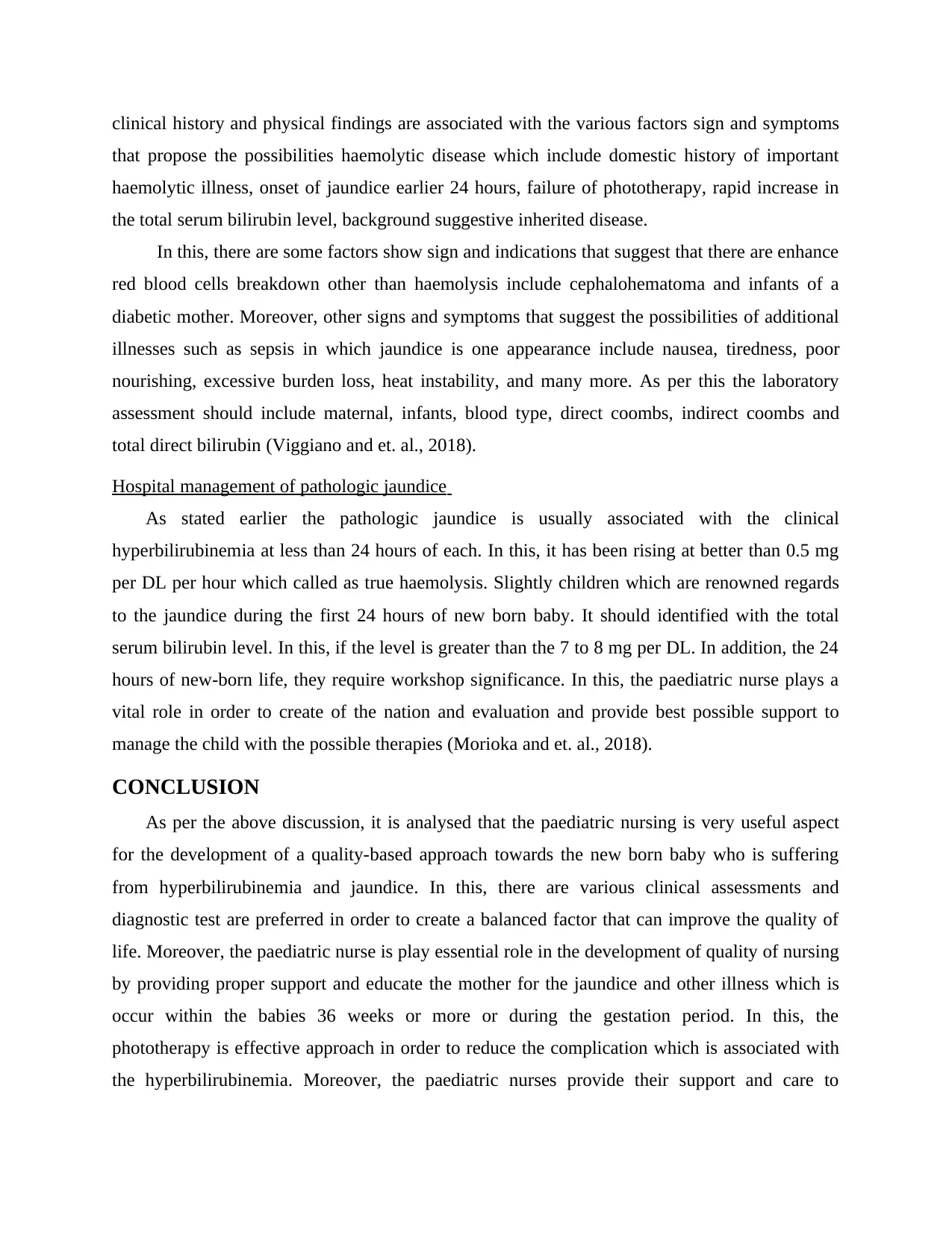
clinical history and physical findings are associated with the various factors sign and symptoms
that propose the possibilities haemolytic disease which include domestic history of important
haemolytic illness, onset of jaundice earlier 24 hours, failure of phototherapy, rapid increase in
the total serum bilirubin level, background suggestive inherited disease.
In this, there are some factors show sign and indications that suggest that there are enhance
red blood cells breakdown other than haemolysis include cephalohematoma and infants of a
diabetic mother. Moreover, other signs and symptoms that suggest the possibilities of additional
illnesses such as sepsis in which jaundice is one appearance include nausea, tiredness, poor
nourishing, excessive burden loss, heat instability, and many more. As per this the laboratory
assessment should include maternal, infants, blood type, direct coombs, indirect coombs and
total direct bilirubin (Viggiano and et. al., 2018).
Hospital management of pathologic jaundice
As stated earlier the pathologic jaundice is usually associated with the clinical
hyperbilirubinemia at less than 24 hours of each. In this, it has been rising at better than 0.5 mg
per DL per hour which called as true haemolysis. Slightly children which are renowned regards
to the jaundice during the first 24 hours of new born baby. It should identified with the total
serum bilirubin level. In this, if the level is greater than the 7 to 8 mg per DL. In addition, the 24
hours of new-born life, they require workshop significance. In this, the paediatric nurse plays a
vital role in order to create of the nation and evaluation and provide best possible support to
manage the child with the possible therapies (Morioka and et. al., 2018).
CONCLUSION
As per the above discussion, it is analysed that the paediatric nursing is very useful aspect
for the development of a quality-based approach towards the new born baby who is suffering
from hyperbilirubinemia and jaundice. In this, there are various clinical assessments and
diagnostic test are preferred in order to create a balanced factor that can improve the quality of
life. Moreover, the paediatric nurse is play essential role in the development of quality of nursing
by providing proper support and educate the mother for the jaundice and other illness which is
occur within the babies 36 weeks or more or during the gestation period. In this, the
phototherapy is effective approach in order to reduce the complication which is associated with
the hyperbilirubinemia. Moreover, the paediatric nurses provide their support and care to
that propose the possibilities haemolytic disease which include domestic history of important
haemolytic illness, onset of jaundice earlier 24 hours, failure of phototherapy, rapid increase in
the total serum bilirubin level, background suggestive inherited disease.
In this, there are some factors show sign and indications that suggest that there are enhance
red blood cells breakdown other than haemolysis include cephalohematoma and infants of a
diabetic mother. Moreover, other signs and symptoms that suggest the possibilities of additional
illnesses such as sepsis in which jaundice is one appearance include nausea, tiredness, poor
nourishing, excessive burden loss, heat instability, and many more. As per this the laboratory
assessment should include maternal, infants, blood type, direct coombs, indirect coombs and
total direct bilirubin (Viggiano and et. al., 2018).
Hospital management of pathologic jaundice
As stated earlier the pathologic jaundice is usually associated with the clinical
hyperbilirubinemia at less than 24 hours of each. In this, it has been rising at better than 0.5 mg
per DL per hour which called as true haemolysis. Slightly children which are renowned regards
to the jaundice during the first 24 hours of new born baby. It should identified with the total
serum bilirubin level. In this, if the level is greater than the 7 to 8 mg per DL. In addition, the 24
hours of new-born life, they require workshop significance. In this, the paediatric nurse plays a
vital role in order to create of the nation and evaluation and provide best possible support to
manage the child with the possible therapies (Morioka and et. al., 2018).
CONCLUSION
As per the above discussion, it is analysed that the paediatric nursing is very useful aspect
for the development of a quality-based approach towards the new born baby who is suffering
from hyperbilirubinemia and jaundice. In this, there are various clinical assessments and
diagnostic test are preferred in order to create a balanced factor that can improve the quality of
life. Moreover, the paediatric nurse is play essential role in the development of quality of nursing
by providing proper support and educate the mother for the jaundice and other illness which is
occur within the babies 36 weeks or more or during the gestation period. In this, the
phototherapy is effective approach in order to reduce the complication which is associated with
the hyperbilirubinemia. Moreover, the paediatric nurses provide their support and care to
Paraphrase This Document
Need a fresh take? Get an instant paraphrase of this document with our AI Paraphraser
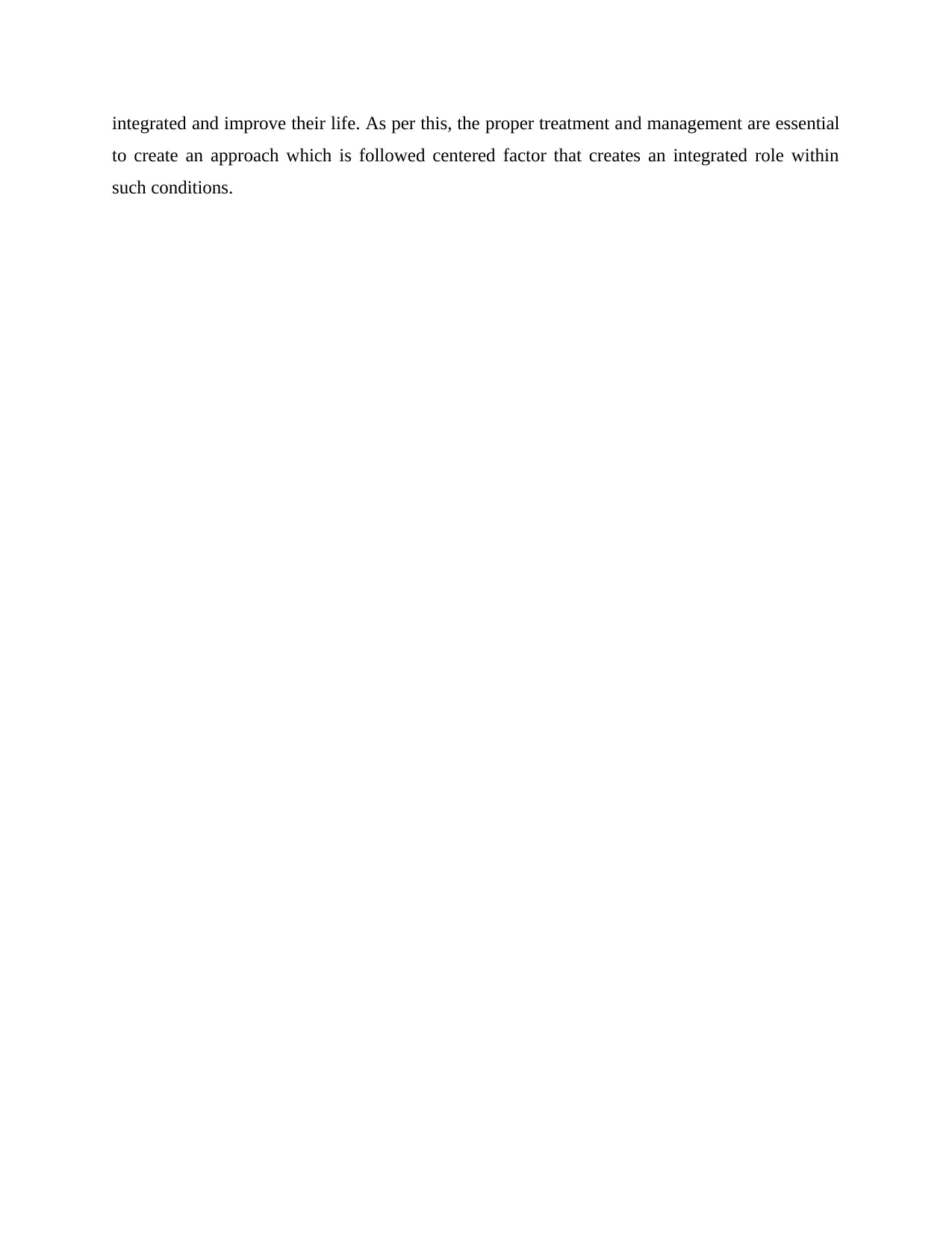
integrated and improve their life. As per this, the proper treatment and management are essential
to create an approach which is followed centered factor that creates an integrated role within
such conditions.
to create an approach which is followed centered factor that creates an integrated role within
such conditions.
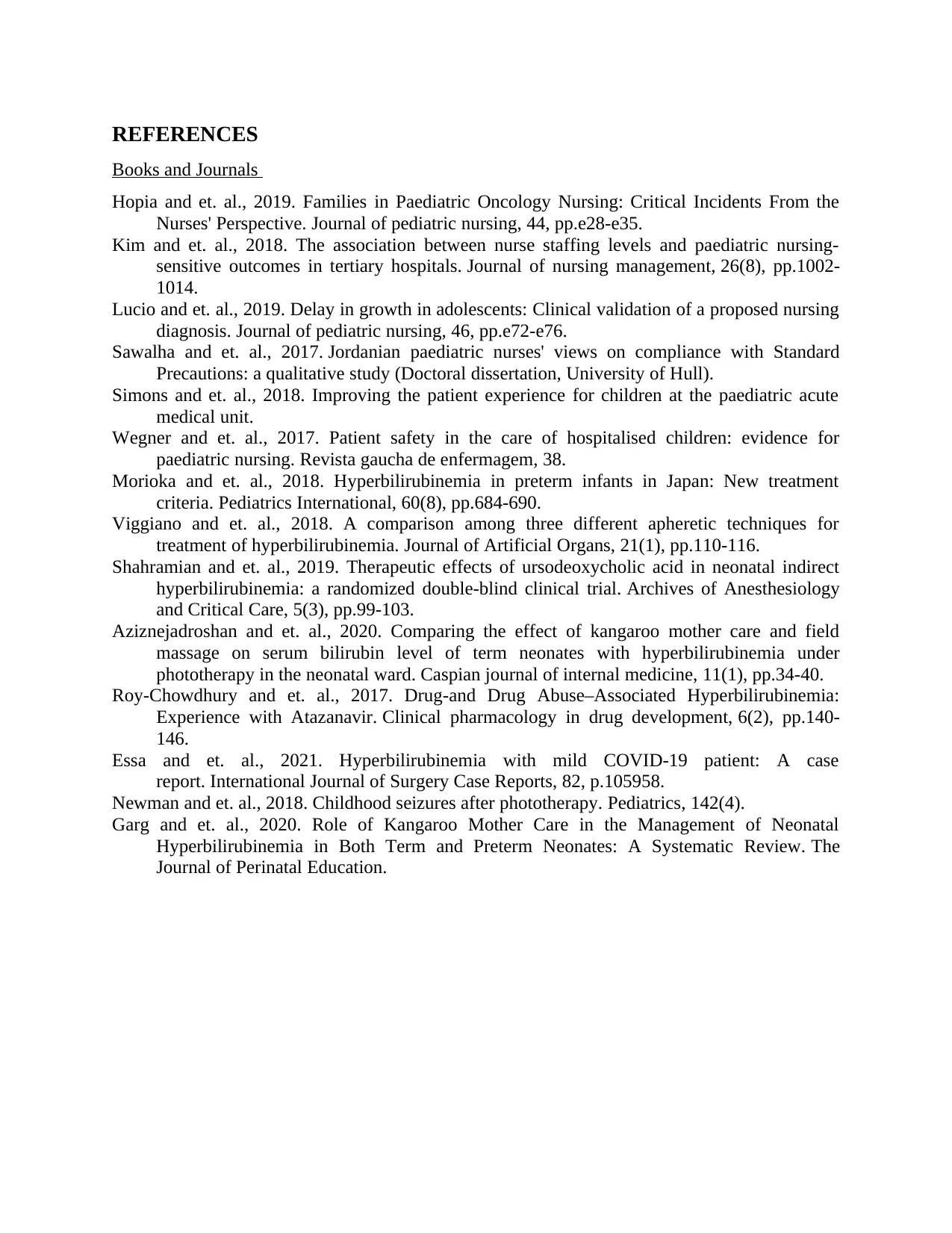
REFERENCES
Books and Journals
Hopia and et. al., 2019. Families in Paediatric Oncology Nursing: Critical Incidents From the
Nurses' Perspective. Journal of pediatric nursing, 44, pp.e28-e35.
Kim and et. al., 2018. The association between nurse staffing levels and paediatric nursing‐
sensitive outcomes in tertiary hospitals. Journal of nursing management, 26(8), pp.1002-
1014.
Lucio and et. al., 2019. Delay in growth in adolescents: Clinical validation of a proposed nursing
diagnosis. Journal of pediatric nursing, 46, pp.e72-e76.
Sawalha and et. al., 2017. Jordanian paediatric nurses' views on compliance with Standard
Precautions: a qualitative study (Doctoral dissertation, University of Hull).
Simons and et. al., 2018. Improving the patient experience for children at the paediatric acute
medical unit.
Wegner and et. al., 2017. Patient safety in the care of hospitalised children: evidence for
paediatric nursing. Revista gaucha de enfermagem, 38.
Morioka and et. al., 2018. Hyperbilirubinemia in preterm infants in Japan: New treatment
criteria. Pediatrics International, 60(8), pp.684-690.
Viggiano and et. al., 2018. A comparison among three different apheretic techniques for
treatment of hyperbilirubinemia. Journal of Artificial Organs, 21(1), pp.110-116.
Shahramian and et. al., 2019. Therapeutic effects of ursodeoxycholic acid in neonatal indirect
hyperbilirubinemia: a randomized double-blind clinical trial. Archives of Anesthesiology
and Critical Care, 5(3), pp.99-103.
Aziznejadroshan and et. al., 2020. Comparing the effect of kangaroo mother care and field
massage on serum bilirubin level of term neonates with hyperbilirubinemia under
phototherapy in the neonatal ward. Caspian journal of internal medicine, 11(1), pp.34-40.
Roy‐Chowdhury and et. al., 2017. Drug‐and Drug Abuse–Associated Hyperbilirubinemia:
Experience with Atazanavir. Clinical pharmacology in drug development, 6(2), pp.140-
146.
Essa and et. al., 2021. Hyperbilirubinemia with mild COVID-19 patient: A case
report. International Journal of Surgery Case Reports, 82, p.105958.
Newman and et. al., 2018. Childhood seizures after phototherapy. Pediatrics, 142(4).
Garg and et. al., 2020. Role of Kangaroo Mother Care in the Management of Neonatal
Hyperbilirubinemia in Both Term and Preterm Neonates: A Systematic Review. The
Journal of Perinatal Education.
Books and Journals
Hopia and et. al., 2019. Families in Paediatric Oncology Nursing: Critical Incidents From the
Nurses' Perspective. Journal of pediatric nursing, 44, pp.e28-e35.
Kim and et. al., 2018. The association between nurse staffing levels and paediatric nursing‐
sensitive outcomes in tertiary hospitals. Journal of nursing management, 26(8), pp.1002-
1014.
Lucio and et. al., 2019. Delay in growth in adolescents: Clinical validation of a proposed nursing
diagnosis. Journal of pediatric nursing, 46, pp.e72-e76.
Sawalha and et. al., 2017. Jordanian paediatric nurses' views on compliance with Standard
Precautions: a qualitative study (Doctoral dissertation, University of Hull).
Simons and et. al., 2018. Improving the patient experience for children at the paediatric acute
medical unit.
Wegner and et. al., 2017. Patient safety in the care of hospitalised children: evidence for
paediatric nursing. Revista gaucha de enfermagem, 38.
Morioka and et. al., 2018. Hyperbilirubinemia in preterm infants in Japan: New treatment
criteria. Pediatrics International, 60(8), pp.684-690.
Viggiano and et. al., 2018. A comparison among three different apheretic techniques for
treatment of hyperbilirubinemia. Journal of Artificial Organs, 21(1), pp.110-116.
Shahramian and et. al., 2019. Therapeutic effects of ursodeoxycholic acid in neonatal indirect
hyperbilirubinemia: a randomized double-blind clinical trial. Archives of Anesthesiology
and Critical Care, 5(3), pp.99-103.
Aziznejadroshan and et. al., 2020. Comparing the effect of kangaroo mother care and field
massage on serum bilirubin level of term neonates with hyperbilirubinemia under
phototherapy in the neonatal ward. Caspian journal of internal medicine, 11(1), pp.34-40.
Roy‐Chowdhury and et. al., 2017. Drug‐and Drug Abuse–Associated Hyperbilirubinemia:
Experience with Atazanavir. Clinical pharmacology in drug development, 6(2), pp.140-
146.
Essa and et. al., 2021. Hyperbilirubinemia with mild COVID-19 patient: A case
report. International Journal of Surgery Case Reports, 82, p.105958.
Newman and et. al., 2018. Childhood seizures after phototherapy. Pediatrics, 142(4).
Garg and et. al., 2020. Role of Kangaroo Mother Care in the Management of Neonatal
Hyperbilirubinemia in Both Term and Preterm Neonates: A Systematic Review. The
Journal of Perinatal Education.
1 out of 9
Related Documents
Your All-in-One AI-Powered Toolkit for Academic Success.
+13062052269
info@desklib.com
Available 24*7 on WhatsApp / Email
![[object Object]](/_next/static/media/star-bottom.7253800d.svg)
Unlock your academic potential
© 2024 | Zucol Services PVT LTD | All rights reserved.




